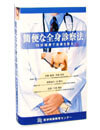| ■ Concise Physical Examination 15-minute Assessment ( 1 volume ) Japanese Edition | |||||||||
 | This video, designed to be an educational tool for a diagnostics training in internal medicine, explains the typical procedures required for physical examination. It introduces how a doctor can conduct "concise physical examinations" systematically and smoothly in a brief period of time. |
|
|||||||
| ■
Supervisor: Yoshiyasu Terashima (Assistant Professor, Research Center of Integrated Education of Health Bioscience, University of Tokushima Graduate School) ■ Academic support: Kenji Tani (Assistant Professor, Internal Medicine and Molecular Therapeutics, Research Center of Integrated Education of Health Bioscience, University of Tokushima Graduate School) ■ Acting: Hiroaki Muguruma (Assistant, Internal Medicine and Molecular Therapeutics, Research Center of Integrated Education of Health Bioscience, University of Tokushima Graduate School) |
|||||||||



